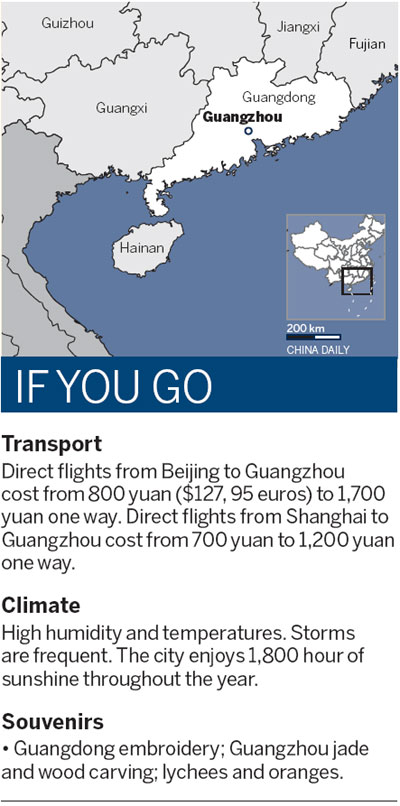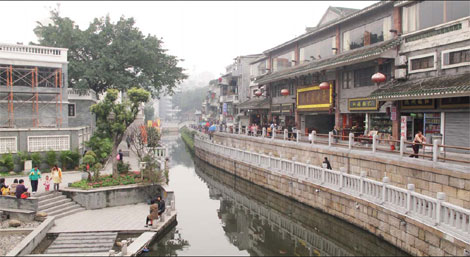Canton calling
Updated: 2012-03-30 07:39
(China Daily)
|
||||||||
|
Many old houses remain standing along the Lizhiwan Creek in Xiguan district of Guangzhou. [Yang Yang / China Daily] |
Southern economic hub continues to entice with old and new
Guangzhou, China's third-largest city after Beijing and Shanghai, is justifiably proud of its place in the country's history and culture. Known previously as Canton, the city is the capital of Guangdong province, which is China's wealthiest in terms of GDP.
Guangzhou is located on the Pearl River Delta, facing Hong Kong island 120 kilometers across the sea. Situated within the region that is historically known for its openness to the outside world, Guangzhou is now a crucial part of the country's economic powerhouse, a key national transportation hub and the largest trading port in South China.
But the city's charm goes far beyond its highly developed economy. With a history dating back more than 2,200 years, its place in modern China's revolutionary history as well as its globally famous Cantonese cuisine offer a vibrant mix of old and new.
1. Xiguan
Xiguan is located in central Liwan district, outside the west gate of the Guangzhou of ancient times.
During the Ming and Qing dynasties, the area was the city's economic center, home to rich merchants and powerful officials. Centuries later, the wealth and power of those times can still be glimpsed through grand old houses, which number less than 100 from a peak of more than 800 since the end of the Qing Dynasty (1644-1911) to the very beginning of the Republic of China.
The architecture of the old houses varies. Some are in traditional Chinese style, some mix the styles of East and West and some are purely Western. But all the buildings are majestic and opulent. Anyone can walk through the old alleys and streets to see these buildings.
The Liwan Museum has a good display on the history and cultural significance of Xiguan's old houses.
2. Shamian Island
Shamian, a small island in west Guangzhou connected by bridges to the outside world, boasts Western-style buildings that reflect the city's relations with the outside world.
In ancient times, the area was a key ferry point for domestic and foreign trade and a scenic spot until the outbreak of the Opium wars, after which Shamian became British and French concessions.
Most of the European-style buildings built in the 19th century were used by foreign companies and consulates. The remaining 50 buildings have European-style facades.
Shamian offers a tranquil respite from downtown Guangzhou.
3. Former Site of Huangpu Military Academy
The academy, on Changzhou Island of east Guangzhou's Huangpu district, was founded by Sun Yat-sen in 1924 with help from the former Soviet Union and the Communist Party of China. It has a main campus with a two-story quadrangle building in the style of the local Chinese ancestral hall.
Huangpu is important in China's modern and contemporary revolutionary history. As one of the world's top four military academies, it helped train many well-known leaders and military commanders of the main two parties in modern Chinese history. The Kuomintang leader Chiang Kai-shek was the principal, and the first premier of the People's Republic of China Zhou Enlai also worked at Huangpu.
4. Eating and Drinking
Guangzhou's Cantonese cuisine is one of the eight main Chinese cuisines. It is famous worldwide.
The city's geographic location and southern, subtropical climate come together to offer special dishes that delight the palate.
Dim sum, the small bite-sized dishes taken with tea that many people associate with the best of Chinese cuisine, is in its element here.
Guangzhou's snack cuisine consists of porridges, rice noodles, cakes, sweets and glutinous rice dumplings.
Beside tea and snacks, people in Guangzhou enjoy "slow-cooked soup" based on principles of traditional Chinese medicine as a way to cope with the hot and humid climate.
Locals say "one finds the best tastes in Xiguan when eating in Guangzhou". Visitors can find traditional restaurants on Longjin East Road, Baohua Road, Shifu Road and also the gourmet park beside the Liwan Lake in Xiguan.
Guangzhou Gourmet Park is at the junction of Bantang Road and Zhongshanba Road, inside the Lizhiwan leisure zone beside Liwan Lake. As a well-known gourmet street in Xiguan, it boasts traditional establishments such as Panxi Restaurant, Xiguanshijia (restaurant) as well as local eateries such as Shahefencun (Shahe rice noodles) and Guangzhou Home.
Huifudong Gourmet Street in Yuexiu district is on Yushan Road, Huifudong Road, Shufang Street and close to Beijinglu Pedestrian Street. Traditional Lingnan (a region that covers Guangdong, Hunan, Jiangxi provinces and Guangxi Zhuang autonomous region) food and delicacies can be found in Yushan Road. Huifudong Road offers traditional Lingnan food and Southeast Asian food. A food park is located on Shufangjie.
China Daily


 Relief reaches isolated village
Relief reaches isolated village
 Rainfall poses new threats to quake-hit region
Rainfall poses new threats to quake-hit region
 Funerals begin for Boston bombing victims
Funerals begin for Boston bombing victims
 Quake takeaway from China's Air Force
Quake takeaway from China's Air Force
 Obama celebrates young inventors at science fair
Obama celebrates young inventors at science fair
 Earth Day marked around the world
Earth Day marked around the world
 Volunteer team helping students find sense of normalcy
Volunteer team helping students find sense of normalcy
 Ethnic groups quick to join rescue efforts
Ethnic groups quick to join rescue efforts
Most Viewed
Editor's Picks

|

|

|

|

|

|
Today's Top News
Chinese fleet drives out Japan's boats from Diaoyu
Health new priority for quake zone
Inspired by Guan, more Chinese pick up golf
Russia criticizes US reports on human rights
China, ROK criticize visits to shrine
Sino-US shared interests emphasized
China 'aims to share its dream with world'
Chinese president appoints 5 new ambassadors
US Weekly

|

|








